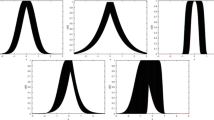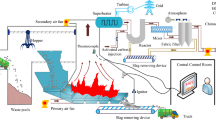Abstract
Soft clustering is able to handle overlapping data thanks to membership functions that allow examples to belong to several clusters. However, the formula linking membership functions to centers and the adoption of fixed time steps, when updating the parameters, prevents research from exploring areas that may be promising. To alleviate this complexity and enlarge the search space, we propose a constrained optimization model that de-assigns memberships from centers. To take advantage of the ability of neural networks to understand the characteristics of the data and of dynamic systems to remember previous groupings, we solve the proposed model by the third-order gradient recurrent network whose stability point is formed by the memberships and the centers. In this respect, the fixed time step Euler-Cauchy algorithm prevents the search from exploring promising regions. To remedy this problem, we adopt a variable time step that allows a maximum decay of the Lyaponuv function at each iteration. We demonstrate that dissociating the membership coefficients from the group centers results in a less complex optimization model with a larger set of feasible solutions offering better optimal fuzzy clustering. We compared our method to different clustering methods basing on silhouette, separability, compactness criterion, and on Dunn’s index; our method has shown its superiority on academic data sets. We used our method to group plants based on 24 nutrients which results in a better classification in comparison with the unidimensional methods.






Similar content being viewed by others
Explore related subjects
Discover the latest articles, news and stories from top researchers in related subjects.References
Kriegel, H.-P., Kroger, P., Sander, J., Zimek, A.: Density-based clustering. WIREs Data Mining Knowl. Discov. 1(3), 231–240 (2011)
Govaert, G., Nadif, M.: Block clustering with bernoulli mixture models: comparison of different approaches. Comput. Stat. Data Anal. 52(6), 3233–3245 (2008)
Mirkin, B.: Mathematical Classification and Clustering. Kluwer Academic Publishers, New York (1996)
Hartuv, E., Shamir, R.: A clustering algorithm based on graph connectivity. Inf. Process. Lett. 76(4–6), 175–181 (2000)
Kohonen, T.: Self-organized formation of topologically correct feature maps. Biol. Cybern. 43(1), 59–69 (1982)
Ettaouil, M., Ghanou, Y., Elmoutaouakil, K., Lazaar, M.: A new architecture optimization model for the Kohonen networks and clustering. J. Adv. Res. Comput. Sci. 3(1), 14–32 (2011)
Ettaouil, M., Lazaar, M.: Improved self-organizing maps and speech compression. Int. J. Comput. Sci. Issues 9(2), 197 (2012)
Ettaouil, M., Lazaar, M., Elmoutaouakil, K., Haddouch, K.: A new algorithm for optimization of the Kohonen network architectures using the continuous Hopfield networks. WSEAS Trans. Comput. 12(4), 155–163 (2013)
Jain, A.K., Dubes, R.C.: Algorithms for clustering data. Prentice-Hall, North Holland (1988)
Murtagh, F.: A survey of algorithms for contiguity-constrained clustering and related problems. Comput. J. 28, 82–88 (1985)
Yacoub M., Badran F., Thiria S.: Topological Hierarchical Clustering: Application to Ocean Color Classification, ICANN’2001, Springer 2001, Proceedings, p. 492–499 92001).
Gan, G., Ma, C., Wu, J.: Data clustering: theory, algorithms, and applications. Society for Industrial and Applied Mathematics (2020).
Manly, B.F.: Randomization, Bootstrap and Monte Carlo Methods in Biology: Texts in Statistical Science. Chapman and Hhall/CRC, New York (2018)
Ruspini, E.H., Bezdek, J.C., Keller, J.M.: Fuzzy clustering: a historical perspective. IEEE Comput. Intell. Mag. 14(1), 45–55 (2019)
Munusamy, S., Murugesan, P.: Modified dynamic fuzzy c-means clustering algorithm–application in dynamic customer segmentation. Appl. Intell. 50(6), 1922–1942 (2020)
El Moutaouakil, K., Touhafi, A.: A New Recurrent Neural Network Fuzzy Mean Square Clustering Method. In: 2020 5th International Conference on Cloud Computing and Artificial Intelligence: Technologies and Applications (CloudTech), Marrakesh, Morocco, 2020, pp. 1–5, https://doi.org/10.1109/CloudTech49835.2020.9365873.
Vuorimaa, P.: Fuzzy self-organizing map. Fuzzy Sets Syst. 66(2), 223–231 (1994)
Pennington, J.A.T., Fisher, R.A.: Classification of fruits and vegetables. J. Food Compos. Anal. 22, S23–S31 (2009). https://doi.org/10.1016/j.jfca.2008.11.012
Gan, G., Chaoqun, M.A., Wu, J.: Data clustering: theory, algorithms, and applications. Society for Industrial and Applied Mathematics (2020)
Chen, Q., Pan, G.: A structure-self-organizing DBN for image recognition. Neural Comput. Appl. 33, 877–886 (2021)
Venkatkumar, I.A., Shardaben, S.J.K.: Comparative study of data mining clustering algorithms. In: 2016 International Conference on Data Science and Engineering (ICDSE), Cochin, 2016, pp. 1–7. https://doi.org/10.1109/ICDSE.2016.7823946
Rueda, A., Krishnan, S.: Clustering Parkinson’s and age-related voice impairment signal features for unsupervised learning. Adv. Data Sci. Adapt. Anal. 10(02), 1840007 (2018)
Mahdavi, M., Chehreghani, M.H., Abolhassani, H., Forsati, R.: Novel meta-heuristic algorithms for clustering web documents. Appl. Math. Comput. 201(1–2), 441–451 (2008)
Guo, D., Chen, J., Chen, Y., Li, Z.: LBIRCH: an improved BIRCH algorithm based on link. In: Proceedings of the 2018 10th International Conference on Machine Learning and Computing, pp. 74–78 (2018, February).
Schubert, E., Rousseeuw, P.J.: Faster k-medoids clustering: improving the PAM, CLARA, and CLARANS algorithms. In International conference on similarity search and applications, pp. 171–187. Springer, Cham (2019, October).
Samudi, S., Widodo, S., Brawijaya, H.: The K-Medoids clustering method for learning applications during the COVID-19 pandemic. Sinkron 5(1), 116–121 (2020)
Cao, F., Liang, J., Li, D., Bai, L., Dang, C.: A dissimilarity measure for the k-Modes clustering algorithm. Knowl.-Based Syst. 26, 120–127 (2012)
Xu, X, Ester, M., Kriegel, H., Sander, J.: A distribution-based clustering algorithm for mining in large spatial databases. In: Proceedings 14th International Conference on Data Engineering, Orlando, FL, USA, 1998, pp. 324–331. https://doi.org/10.1109/ICDE.1998.655795
Nayyar, A., Puri, V.: Comprehensive analysis and performance comparison of clustering algorithms for big data. Rev. Comput. Eng. Res. 4(2), 54–80 (2017)
Kriegel, H.-P., Kroger, P., Sander, J., Zimek, A.: Density-based clustering. WIREs Data Mining Knowl Discov 1, 231–240 (2011). https://doi.org/10.1002/widm.30
Corizzo, R., Pio, G., Ceci, M., Malerba, D.: DENCAST: distributed density-based clustering for multi-target regression. J. Big Data 6(1), 1–27 (2019)
Yu, H., Chen, L., Yao, J., Wang, X.: A three-way clustering method based on an improved DBSCAN algorithm. Physica A 535, 122289 (2019)
Simpson, P.K.: Fuzzy min-max neural network—Part II: Clustering. IEEE Trans. Fuzzy Syst. 1(1), 32–45 (1993)
Haddouch, K., El Moutaouakil, K.: New Starting Point of the Continuous Hopfield Network. In : International Conference on Big Data, Cloud and Applications. Springer, Cham, p. 379–389 (2018)
Haddouch, K., El Moutaouakil, K.: New checker for constraint network solutions. In: Proceedings of the 2nd international Conference on Big Data, Cloud and Applications, pp. 1–6 (2017)
Senhaji, K., El Moutaouakil, K., Ettaouil, M.: A robust neural network approach for the portfolio selection problem basing on new rational models. J. Eng. Appl. Sci. 14(3), 675–683 (2019)
Talavan, P.M., Yanez, J.: The generalized quadratic knapsack problem. A neuronal; network approach. Neural Netw. 19, 416–428 (2006)
Michaud, D., Pietinen, P., Taylor, P., et al.: Intakes of fruits and vegetables, carotenoids and vitamins A, E, C in relation to the risk of bladder cancer in the ATBC cohort study. Br. J. Cancer 87, 960–965 (2002). https://doi.org/10.1038/sj.bjc.6600604
Holick, M.F.: Vitamin D and bone health. J. Nutr. 126(suppl4), 1159S-1164S (1996). https://doi.org/10.1093/jn/126.suppl4.1159S
Rezaee, M.J., Eshkevari, M., Saberi, M., Hussain, O.: GBK-means clustering algorithm: an improvement to the K-means algorithm based on the bargaining game. Knowl.-Based Syst. 213, 106672 (2021)
Jiamthapthaksin, R., Eick, C.F., Lee, S.: GAC-GEO: a generic agglomerative clustering framework for geo-referenced datasets. Knowl. Inf. Syst. 29, 597–628 (2011). https://doi.org/10.1007/s10115-010-0355-3
Wang, Z., et al.: Clustering by local gravitation. IEEE Trans. Cybern. 48(5), 1383–1396 (2018)
Gao, M., Shi, G.-Y.: Ship-handling behavior pattern recognition using AIS sub-trajectory clustering analysis based on the T-SNE and spectral clustering algorithms. Ocean Eng. 205, 106919 (2020)
Nidheesh, N., Nazeer, K.A.A., Ameer, P.M.: A Hierarchical Clustering algorithm based on Silhouette Index for cancer subtype discovery from genomic data. Neural Comput. Appl. 32, 11459–11476 (2020)
Alia, O.M.: Dynamic relocation of mobile base station in wireless sensor networks using a cluster-based harmony search algorithm. Inf. Sci. 385, 76–95 (2017)
Bas, E.: A robust optimization approach to diet problem with overall glycemic load as objective function. Appl. Math. Modell. 38(19–20), 4926–4940 (2014)
Hand, D.J. , Adams, N.M.: Data mining. Wiley StatsRef: Statistics Reference Online, 2014, p. 1–7
Mariem, B., Karim, E.M., Satori, K. : A probabilistic vector representation and neural network for text classification. In: International Conference on Big Data, Cloud and Applications. Springer, Cham, 2018. p. 343–355.
Wiseman M.: The Second World Cancer Research Fund/American Institute for Cancer Research Expert Report. Food, Nutrition, Physical Activity, and the Prevention of Cancer: A Global Perspective: Nutrition Society and BAPEN Medical Symposium on ‘Nutrition support in cancer therapy’. Proc. Nutr. Soc. 67(3), 253–256 (2008)
Eick, C.F., Zeidat, N., Zhao, Z.: Supervised clustering - algorithms and benefits. In: 16th IEEE International Conference on Tools with Artificial Intelligence, Boca Raton, FL, USA, 2004, pp. 774–776. https://doi.org/10.1109/ICTAI.2004.111
Ketchen, D.J., Shook, C.L.: The application of cluster analysis in Strategic Management Research: an analysis and critique. Strategic Manag. J. 17(6), 441–458 (1996)
Law, M.H.C., Figueiredo, M., Jain, A.K.: Simultaneous feature selection and clustering using mixture models. IEEE Trans. Pattern Anal. Mach. Intell. 26(9), 1154–1166 (2004)
Goutte, C., Hansen, L.K., Liptrot, M.G., Rostrup, E.: Feature-space clustering for fMRI meta-analysis. Hum. Brain Map. 13(3), 165–183 (2001). https://doi.org/10.1002/hbm.1031
Sugar, C.A., James, G.M.: Finding the number of clusters in a data set: an information-theoretic approach. J. Am. Stat. Assoc. 98, 750–763 (2003). https://doi.org/10.1198/016214503000000666
Stuart, T., Butler, A., Hoffman, P., Hafemeister, C., Papalexi, E., Mauck, W.M., III., Satija, R.: Comprehensive integration of single-cell data. Cell 177(7), 1888–1902 (2019)
Finding the Right Number of Clusters in k-Means and EM Clustering: v-Fold Cross-Validation”. Electronic Statistics Textbook. StatSoft. 2010. Retrieved 2010-05-03
Honarkhah, M., Caers, J.: Stochastic simulation of patterns using distance-based pattern modeling. Math. Geosci. 42(5), 487–517 (2010). https://doi.org/10.1007/s11004-010-9276-7
Kent, J.T., Ganeiber, A.M., Mardia, K.V.: A new unified approach for the simulation of a wide class of directional distributions. J. Comput. Graph. Stat. 27(2), 291–301 (2018)
Patibandla, R.S.M.L., Veeranjaneyulu, N.: Performance analysis of partition and evolutionary clustering methods on various cluster validation criteria. Arab. J. Sci. Eng. 43(8), 4379–4390 (2018)
Acknowledgements
This work was supported by Ministry of National Education, Professional Training, Higher Education and Scientific Research and the Digital Development Agency (DDA) and CNRST of Morocco (Nos. Alkhawarizmi/2020/23).
Funding
This work is supported by the National Center for Scientific and Technical Research of Morocco via AL-Khawarizmi Artificial Intelligence Program (Grant No. alkhawarizmi/2020/23).
Author information
Authors and Affiliations
Contributions
Corresponding authors: KEM. Data collection: AY. Theoretical part and processing: KEM. Data verification, results analysis, and diet recommendations: HB and SC. Redaction: KEM and AY.
Corresponding author
Ethics declarations
Conflict of interest
The authors declare that they have no conflict of interest.
Ethical Approval
This paper does not contain any studies with human participants or animals performed by any of the authors.
Informed Consent
Informed consent was obtained from all individual participants included in the study.
Rights and permissions
Springer Nature or its licensor holds exclusive rights to this article under a publishing agreement with the author(s) or other rightsholder(s); author self-archiving of the accepted manuscript version of this article is solely governed by the terms of such publishing agreement and applicable law.
About this article
Cite this article
El Moutaouakil, K., Yahyaouy, A., Chellak, S. et al. An Optimized Gradient Dynamic-Neuro-Weighted-Fuzzy Clustering Method: Application in the Nutrition Field. Int. J. Fuzzy Syst. 24, 3731–3744 (2022). https://doi.org/10.1007/s40815-022-01358-0
Received:
Revised:
Accepted:
Published:
Issue Date:
DOI: https://doi.org/10.1007/s40815-022-01358-0




